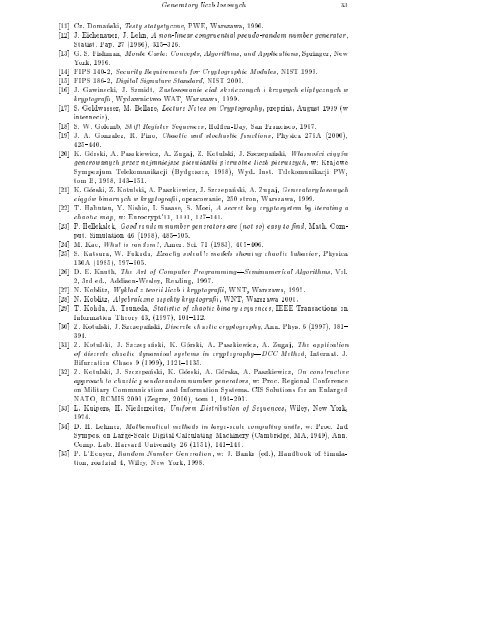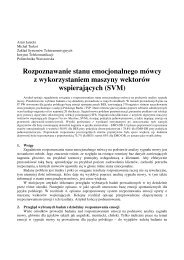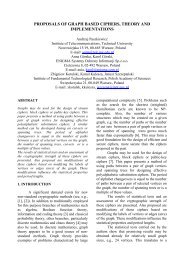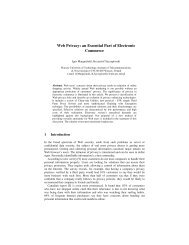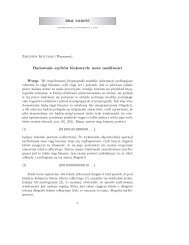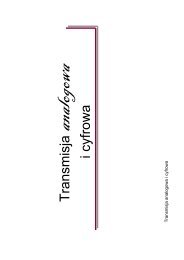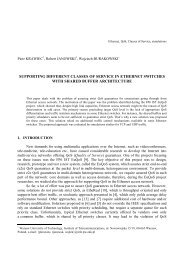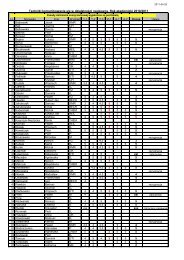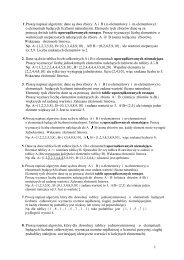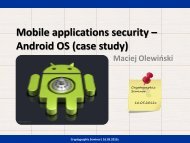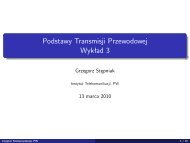Zbigniew Kotulski (Warszawa) Generatory liczb losowych: algorytmy ...
Zbigniew Kotulski (Warszawa) Generatory liczb losowych: algorytmy ...
Zbigniew Kotulski (Warszawa) Generatory liczb losowych: algorytmy ...
Create successful ePaper yourself
Turn your PDF publications into a flip-book with our unique Google optimized e-Paper software.
<strong>Generatory</strong> <strong>liczb</strong> <strong>losowych</strong> 33[11] Cz. Domaski, Testy statystyczne, PWE, <strong>Warszawa</strong>, 1990.[12] J. Eichenauer, J. Lehn, A non-linear congruential pseudo-random number generator,Statist. Pap. 27 (1986), 315{326.[13] G. S. Fishman, Monte Carlo: Concepts Algorithms and Applications, Springer, NewYork, 1996.[14] FIPS 140-2, Security Requirements for Cryptographic Modules, NIST 1999.[15] FIPS 186-2, Digital Signature Standard, NIST 2000.[16] J. Gawinecki, J. Szmidt, Zastosowanie cia skoczonych i krzywych eliptycznych wkryptograi, Wydawnictwo WAT, <strong>Warszawa</strong>, 1999.[17] S. Goldwasser, M. Bellare, Lecture Notes on Cryptography, preprint, August 1999 (winternecie).[18] S. W. Golomb, Shift Register Sequences, Holden-Day, San Francisco, 1967.[19] J. A. Gonzalez, R. Pino, Chaotic and stochastic functions, Physica 276A (2000),425{440.[20] K. Grski, A. Paszkiewicz, A. Zugaj, Z. <strong>Kotulski</strong>, J. Szczepaski, Wasnoci cigwgenerowanych przez najmniejsze pierwiastki pierwotne <strong>liczb</strong> pierwszych, w: KrajoweSympozjum Telekomunikacji (Bydgoszcz, 1998), Wyd. Inst. Telekomunikacji PW,tom B, 1998, 143{151.[21] K. Grski, Z. <strong>Kotulski</strong>, A. Paszkiewicz, J. Szczepaski, A. Zugaj, <strong>Generatory</strong> <strong>losowych</strong>cigw binarnych w kryptograi, opracowanie, 250 stron, <strong>Warszawa</strong>, 1999.[22] T. Habutsu, Y. Nishio, I. Sasase, S. Mori, Asecret key cryptosystem by iterating achaotic map, w: Eurocrypt'91, 1991, 127{140.[23] P. Hellekalek, Good random number generators are (not so) easy to nd, Math. Comput.Simulation 46 (1998), 485{505.[24] M. Kac, What is random?, Amer. Sci. 71 (1983), 405{406.[25] S. Katsura, W. Fukuda, Exactly solvable models showing chaotic bahavior, Physica130A (1985), 597{605.[26] D. E. Knuth, The Art of Computer Programming|Seminumerical Algorithms, Vol.2, 3rd ed., Addison-Wesley, Reading, 1997.[27] N. Koblitz, Wykad z teorii <strong>liczb</strong> i kryptograi, WNT, <strong>Warszawa</strong>, 1995.[28] N. Koblitz, Algebraiczne aspekty kryptograi, WNT,<strong>Warszawa</strong> 2000.[29] T. Kohda, A. Tsuneda, Statistic of chaotic binary sequences, IEEETransactions onInformation Theory 43, (1997), 104{112.[30] Z. <strong>Kotulski</strong>, J. Szczepaski, Discrete chaotic cryptography,Ann.Phys. 6 (1997), 381{394.[31] Z. <strong>Kotulski</strong>, J. Szczepaski, K. Grski, A. Paszkiewicz, A. Zugaj, The applicationof discrete chaotic dynamical systems in cryptography|DCC Method, Internat. J.Bifurcation Chaos 9 (1999), 1121{1135.[32] Z. <strong>Kotulski</strong>, J. Szczepaski, K. Grski, A. Grska, A. Paszkiewicz, On constructiveapproach to chaotic pseudorandom number generators, w: Proc. Regional Conferenceon Military Communication and Information Systems. CIS Solutions for an EnlargedNATO, RCMIS 2000 (Zegrze, 2000), tom 1, 191{203.[33] L. Kuipers, H. Niederreiter, Uniform Distribution of Sequences, Wiley,NewYork,1974.[34] D. H. Lehmer, Mathematical methods in large-scale computing units, w: Proc. 2ndSympos. on Large-Scale Digital Calculating Machinery (Cambridge, MA, 1949), Ann.Comp. Lab. Harvard University 26 (1951), 141{146.[35] P. L'Ecuyer, Random Number Generation, w: J. Banks (ed.), Handbook of Simulation,rozdzia 4, Wiley, New York, 1998.


